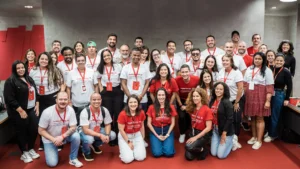No one needs to know much about tennis to have heard of tennis player Serena Williams, after all, she is considered one of the greatest athletes of all time – in any sport.
Serena, now 42 years old, has already retired her rackets. But he continues to be a great influence on and off the court for both young tennis players and the general public, for working hard and always striving for excellence.
On the court, the former American tennis player imposed her personality and revolutionized women's tennis. With a powerful playing style, high athleticism and an extremely competitive mentality, she is the female record holder for individual Grand Slam titles – 23, compared to 24 for the male record holder, Novak Djokovic, still in action.
Alongside her sister, Venus, she made a strong impact on the world of tennis – until then predominantly white – with her bold way and added 14 Grand Slam doubles titles to her trophy gallery.
With gold medals at the 2000, 2008 and 2012 Olympics, they are the winningest pair in Olympic history.
After all, who is tennis player Serena Williams?
Born in the United States, Serena Williams played for 27 years as a professional tennis player and is considered one of the greatest in history. She won 72 singles titles in her career, a mark surpassed only by four athletes: Martina Navratilova (167), Chris Evert (154), Steffi Graf (107) and Margaret Smith Court (92).
After so many achievements, tennis player Serena Williams ended her career in 2022. But her successful journey didn't stop there. Off the court, she defines herself as a tennis player turned entrepreneur: she has launched clothing and jewelry lines, opened two schools in Kenya and works as a Unicef Goodwill Ambassador.
Additionally, in 2014 she founded a venture capital firm, Serena Ventures, which invests in technology companies founded or led by women and people of color.
Now she comes to Brazil to tell her story of entrepreneurship and resilience and share your experience as a businesswoman with the entrepreneurs who will participate in the iFood Move, the largest meeting to debate the future of food delivery businesses in Latin America.
The former tennis player and current entrepreneur is the main speaker at the event, which will be held on September 25th and 26th.
How did Serena Williams get started in tennis?
The curious thing is that the youngest of the five daughters of the Williams family spent her childhood watching her father, Richard, bet on her sister, Venus, to be a great tennis player, as shown in the film “King Richard”.
He was not a sportsman: with the help of his wife, Oracene, he learned about the sport by watching videos and reading books and taught everything to his daughters.
Since she was three years old, Serena trained with Venus and her father – and worked hard to reach her sister's level, always faster and better with the rackets. As a child, Serena began to be part of the United States Tennis Association's junior team and, at the age of ten, placed first in the division.
The father then realized that the girls were beyond competitive and invested in professional training for the sisters, with coach Rick Macci. The problem is that Rick, unlike the Williams family, didn't want them to start playing as professionals too soon.
He was right. Against her coach's wishes, Serena made her debut in 1995, at the age of 14. And she suffered such a tough defeat that she only returned to the court as a professional two years later.
At the end of 1997, her first year as a professional, Serena was ranked 99th in the world – not bad for a young debutant. The following year would be meteoric: in 1998, it shot to 20The position and became the fastest tennis player to record five wins against the top ten players.
Her first major title (winning a Grand Slam) came in 1999, on home soil, when she won the US Open. She finished the year fourth in the rankings and with a sponsorship deal worth US$ 12 million.
Years of glory and difficulties
From her first title, Serena's career took off, and she became the number 1 tennis player in the world in 2002. At that year's US Open, she also attracted attention by wearing a jumpsuit. A fan of fashion, she became famous for wearing bold clothes that highlighted her physical strength, defying conservative tournament dress codes.
In 2003, Serena Williams won her first Australian Open, and in doing so became one of six women to complete a career Grand Slam (in which a player wins all four major championships) in the Open Era.
The year 2003, however, was also remarkable for other reasons. In addition to undergoing knee surgery, Serena lost her older sister, Yetunde, who was murdered. The injury and the loss of her sister greatly affected the former tennis player, who in the following years fell in the rankings until reaching position 139 in 2007.
The comeback would come in 2008, with another US Open title – then in Australia and Wimbledon – and a return to first place in the world rankings.
Years later, in 2011, a new health problem began to worry Serena: clots in her lung, which would haunt her from then on. She spent almost a year without playing, but she didn't stop. On the contrary: he continued winning Olympic titles and medals until, in 2017, he reached the long-awaited 23The victory in Grand Slams.
By winning the Australian Open, she broke the record for tennis titles by surpassing the previous mark, which belonged to German Steffi Graf. Mission Accomplished? Not for Serena, who then announced that she had fulfilled another dream: she was expecting her first daughter, Alexis Olympia (who, by the way, was already there in her belly when she won the Australian Open).
The legacy of tennis player Serena Williams
Now a mother, Serena returned to competing in 2018, starting from 549th place. Returning to the courts, this time, was more difficult. Despite reaching the Grand Slam finals, she did not win any relevant titles again. After losing the US Open semifinal to young Naomi Osaka and physically hampered by injuries, Serena decided to stop.
In 2022, she announced her retirement, aged 41, after 27 years as a professional. Knowing Serena's determination, the word “retirement” is far from stopping working.
“Perhaps the best word to describe what I’m doing is evolution. I'm evolving from tennis to other things that are important to me. A few years ago, I founded Serena Ventures, a venture capital firm. Soon after, I started a family. I want to make this family grow,” wrote the athlete to Vogue magazine in season. Said and done: in 2023, his second daughter, Adira, was born.
Today, she continues to lead Serena Ventures and her investment portfolio has 79% of companies whose founders come from underrepresented groups, 54% were created by women and 47% by black people. Of these, 14 have already been considered unicorns.
Serena continues to be an advocate for women's rights and racial equality, and uses her visibility to promote important causes and inspire entrepreneurs, like those who will participate in iFood Move.
She will soon tell her story in a new documentary series, “In the Arena: Serena Williams”, which will air in July in the United States.
Why we brought Serena Williams to speak at iFood Move
The one who responds is the CEO of iFood, Diego Barreto: “Serena, in addition to being a tennis player, is a person who brings together a series of characteristics that speak to people in our ecosystem”, explains the executive.
“She wasn’t born with a good life or with all the elements she needed to become the best professional in her sport. She went through countless challenges in a very high-performance sport and had to go back and start over several times.”
For Diego, these are some of the elements that Serena Williams also present in Brazilian entrepreneurs and also in delivery people, waiters and other professionals in the food sector.
“They face difficulties that she also faced. Let's bring in someone who has something to tell us. If we can absorb a little of this, tomorrow will be a little better”, says Diego.


